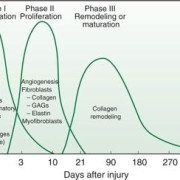TISSUE HEALING
The healing process has three phases: 1. the acute injury phase 2. the repair phase and 3. the remodeling phase.
The acute injury phase starts immediately when connective tissue is damaged and can last 3 – 5 days. The inflammatory response is important in that it is the cleaning process, removing the damaged tissues and bacteria and preparing the body for the next stage. Proper care in the inflammation response phase follows the timeless “Rice” principle – Rest, Ice, Compression, and Elevation. Some textbooks change Rice to Price – the “P” standing for Protection as we control for swelling and pain.
The repair/regeneration phase starts as inflammation subsides, and can last for several weeks depending on the severity of the injury and amount of tissue involved. The body starts to lay down a matrix of collagen fibers (type III) and forms scar tissue. The collagen in this stage is disorganized in orientation and has weak cross-linking and is susceptible to disruption and re-injury if activity if too aggressive. Treatment continues to control for pain and inflammation early in this stage but is less required as the stage continues. Once the new tissue becomes stronger treatment includes regaining range of motion, joint mobilization and scar mobilization. Some cardiovascular activity and neuromuscular control exercises can be started at intensities that match the tolerance of the new tissue. Activity during this stage should be very mild – even walking may irritate the tissues trying to heal.
During the last phase of the healing process, remodeling/maturation, the body lays down the stronger Type I collagen. Type I collagen has much stronger cross-links, therefore it becomes very important to start increasing tension on the tissues to provide guidance for the organizing collagen. Tension is important so that the collagen aligns itself according to the lines of stress to accommodate functional activities of daily life and recreational/sport performance. Activities that provide this tension must be chosen carefully to match the ability of the still healing tissue. The activities are progressive in nature and must allow the person to stop guarding and move toward normal movement patterns. This phase can take months to years depending on the severity of the original injury. An example we can use is a broken bone – we know that within 6 – 8 weeks most bones are healed enough for us to return to normal activities, however that bone will continue to heal for up to a another 12 – 16 months. Yet one more example could be surgery to repair a torn ACL ligament of the knee. Most post surgery protocols have athletes back to full participation with 6 – 7 months of surgery; however most of these athletes perform at a higher level 12 – 14 months post surgery.
Allowing the body the time and correct treatment protocols to heal after an injury is important for long term functioning. I see many people who did not allow this process to occur after an injury, and many years later have great difficulty in creating quality posture and movement patterns. In some cases, treatment protocols or exercises were given that did not match the level of healing or the age/ability of the patient/client. I know some of you ignore proper treatment after an injury (physio, chiro etc) because, well, all they will do is put those machines on me and they do nothing. Well, those machines and the people who run them understand the healing process. The machines are only the start of your recovery, and as you progress through the healing stages the therapist will do a number of manual therapies (joint mobilization, scar mobilization, massage, ROM exercises, acupuncture, IMS) to get you to the point where you can start with weight bearing, balance, movement pattern and simple strength activities. Only after you pass this stage are you ready to resume normal activity without risk of re-injury or long term biomechanical dysfunctions.




